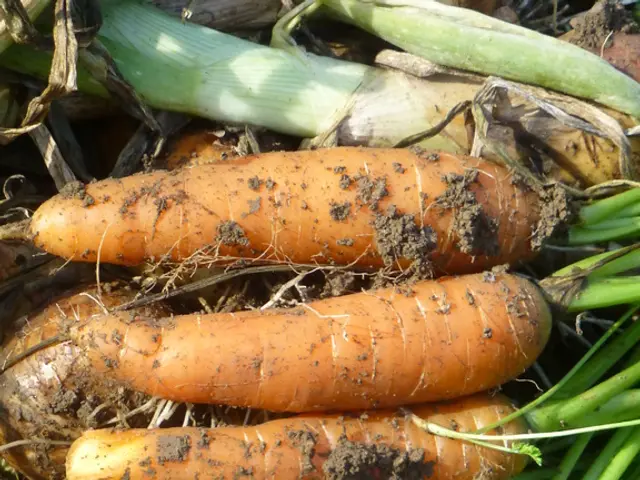Veggie Garden Maintenance: Techniques for Continuous Vegetable Production
Grow More Veggies in Less Space: Master Succession Planting
Turn your garden into a year-round, bountiful bounty with this space-saving, harvest-extending technique! Succession planting is a genius strategy that ensures a continuous supply of veggies throughout your growing season. So, grab your gardening gloves and let's dive into mastering succession planting in your vegetable garden.
Breakdown:
- What is Succession Planting? ❭1. Cultivating a Continuous Harvest. Why Succession Plant? How to Implement Succession Planting. Ideal Edibles for Succession Planting.*** Tips to Triumph
- The Lowdown on Succession Planting
Succession planting revolves around strategically planting your crops in cycles so they ripen at varying times. The primary advantage is that when one harvest is complete, another crop is primed and ready to take its place. This means you'll have a non-stop supply of fresh veggies! For instance, you may plant a row of lettuce, then a week later (or several weeks later), another row, and so on. By the time you're done with the first row, the next two are ready to be picked!
Why Should You Succession Plant?
- Make the Most of Your Garden Space: By continually planting and harvesting, you utilize every inch of your garden, avoiding empty patches.
- Enjoy More Veggies: Instead of settling for just one harvest, you can boost your yield by reaping multiple harvests from the same spot.
- Stay Fresh All Season: If you stagger your plantings, you can savor homegrown veggies from the start of the season all the way through fall.
- Fend Off Pests: By planting crops in sequence, you lower the risk of pest infestations that come with planting a large monocrop (one crop variety covering a substantial area).
Setting the Stages for Succession Planting
- Blueprint Your Garden Layout: Decide on which veggies you'd like to grow and determine their maturity times. Some veggies, such as lettuce and spinach, mature within 30 to 50 days, great for succession planting! Others, like tomatoes or peppers, take longer to mature, so plan accordingly.
- Select the Right Crops: Opt for quick-growing crops that thrive in cooler weather, such as lettuce, kale, peas, and radishes, ideal for early spring and fall plantings. For the warmer months, choose slower-maturing veggies, like tomatoes, beans, and squash.
- Space 'em Out: Plant your seeds sparingly and keep space for your successive plantings. If you're making rows, leave adequate room between them so each new planting has room to flourish.
- Planting Diaries: Track your planting dates to ensure you plant at the right intervals. You can keep a simple garden journal or employ a garden planner app, enabling you to calculate the optimal times for your next plantings.
- Healthy Soil Habits: Keep your soil nutrient-dense to accommodate all the crops you will grow throughout the season. Regularly add compost or organic fertilizers, and rotate crops to counteract soil depletion.
- Timely Transitions: Succession planting isn't merely about spacing out your harvests; it's also about the perfect timing. Plant cool-season crops early in the spring, transition to warm-season veggies in the hotter months, and opt for cool-season crops again in late summer or early fall to maintain your garden's productivity.
Ideal Edibles for Succession Planting
- Lettuce: Now and then, plant a row of lettuce every two weeks to sustain a constant flow of fresh greens in your garden. Lettuce is quick-growing and works well in cooler temperatures.
- Radishes: Given that radishes mature in around 30 days, sprinkle them every 2 to 3 weeks to keep a continuous radish harvest going.
- Beans: Beans are great for warm-weather seasons when you plant them in two-week intervals. This ensures that the beans that are ready when the first batch is done!
- Carrots: Spread out your carrot harvests by planting them in intervals, even though they take a bit longer to mature.
Secrets to Garden Success
- Be Aware of Your Frost Dates: Establish your local frost dates to plant at the appropriate times and avoid damaging your crops with frost.
- Water Watch: Keep tabs on your watering requirements as you stagger your plantings. Be mindful that different plants require varying degrees of hydration.
- Row Covers to the Rescue: If you are extending your season into the cooler months, use row covers to protect your crops from early frost and pesky pests while prolonging your harvest.
- Mulchically Sensible: Mulch your soil in preparation for frequent plantings to retain moisture, keep weeds down, and maintain consistent growing conditions.
Bloom and ProsperSuccession planting is a life-changing strategy for anyone who aims to maximize their veggie garden's potential. Be it a simple way to maintain productivity, offer fresh produce all year long, or optimize your garden space, mastering succession planting will place your garden on the path to success!
- Implementing succession planting in your garden allows you to cultivate a continuous harvest by strategically planting crops in cycles, ensuring a non-stop supply of fresh vegetables.
- By practicing succession planting, you can make the most of your garden space, enjoy more vegetables, stay fresh all season, and fend off pests by planting crops in sequence.
- To set the stages for succession planting, create a garden layout, choose the right crops, space 'em out, keep a planting diary, maintain healthy soil habits, and time your transitions for optimal results. Radishes, lettuce, beans, and carrots are excellent choices for succession planting.








